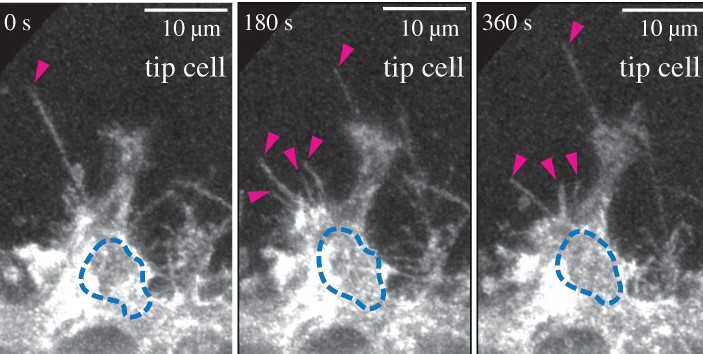Collective Cells Display Simple Cognition
February 17, 2021
Can cells communicate with each other and make shared decisions? It seems they can, and researchers are making progress in understanding how this happens.
Active perception, or the use of collected information from movement and the senses, is a complex process which informs behaviors in humans and other organisms. The process, which is related to cognition and is thus extremely important for animals, has been studied significantly in organisms; yet until recently the question of how cells within these organisms make collective decisions had not been investigated. In a study published earlier this month, researchers from the Francis Crick Institute and King’s College London have provided the first proof of concept demonstrating how cells, through active perception, seek information and make decisions during the complicated and adaptive process of blood vessel formation.
For their proof of concept, the researchers decided to focus on the formation of blood vessels, as this process (known as angiogenesis) is not only crucial for tissue development and regulation, but also because many aspects of its complex timing and cell dynamics are still not fully understood. Angiogenesis, along with the general process of the development of tissues and organs, is so complex because cells in the area of expansion (which do not have any intelligence on their own) must precisely, rapidly, and adaptively coordinate their behavior to create a new and complex system, all under the time constraints of development.
The process of angiogenesis begins when endothelial cells (which layer all blood vessels) select a tip cell which will lead a new sprout from a pre-existing vessel. The other cells will then follow behind this leading tip cell. Tip cells had been well-studied before this study, and are characterized by long, thin, and dynamic protrusions known as filopodia. Before this point, however, it was unclear what determined which endothelial cell would become a tip cell. The researchers discovered that these filopodia, which had previously been considered an end product of the cell decision making process, speed up the time-constrained selection of tip cells through the use of active perception. With computer simulations and studies of zebrafish embryos, the researchers found that filopodia began to form on the surface of endothelial cells before they had committed to becoming tip cells. The filopodia then extended out and “felt” for signals which either triggered or inhibited the cell from becoming a tip cell; the cell that received the most triggers became the new leading tip cell. This discovery reveals that cells in angiogenesis have evolved and employ a rudimentary active perception feedback loop, which is a cognitive process in which cells seek out and use information to make better and faster collective decisions, providing the adaptive problem-solving necessary during angiogenesis.
Interestingly, the movement of filopodia and the decision of endothelial cells happen simultaneously, rather than consecutively like many more basic processes. While the filopodia of each of the endothelial cells are moving, feeling, and receiving signals independently, they are also contributing to the collective decision of the cells; the cells move around while also determining how to form new tissue. This use of active perception to influence choices that the cells are making at the same time is relatively surprising because it is usually associated with intelligent, “higher” organisms. Understanding how these processes work in more basic living systems could reveal underlying aspects of their biological functions.
Along with revealing more of the process of tip cell selection, the important role of filopodia, and the use of active perception in cells, the study has also opened the door for many new research directions and therapeutic possibilities. Limited blood flow due to failed or lacking tip cell selection can contribute to diseases such as retinopathy (a disease of the retina which affects vision) or even cancer. Continued research on the topic could lead to new therapies that can regulate blood vessel density and help resolve these issues. Such therapies could also be helpful in the creation of artificial organs and tissues, which require dense blood vessel networks. Much of angiogenesis, including the process behind how tip cells are selected, is still not fully understood. However, the researchers on the team have taken a remarkable first step. In the future, they hope to continue their work while ultimately better interpreting and understanding the behavior of cells, their intelligence, and their use of active perception to make collective decisions.
Link to the study: Active Perception During Angiogenesis

